
![]() SURFACE-MOUNT PONDS FOR SLIDER AND
OTHER AQUATIC TURTLES
SURFACE-MOUNT PONDS FOR SLIDER AND
OTHER AQUATIC TURTLES
Andy C. Highfield & Nadine Highfield
Step-by-Step Construction Details
For many years it has been common practice to accommodate captive aquatic turtles in glass aquarium tanks. These do, however, have a number of serious drawbacks. They are extremely heavy, they are highly fragile, and all but the very largest models offer inadequate space and water volume for even a medium-sized turtle. Glass tanks are, in addition, very costly. One further drawback is that their ‘hard’ bottom and sides tend to cause bruising to the delicate plastron and carapace, and this, in turn, can lead to an increased risk of serious shell infections.
There is no more miserable sight than a large turtle in a tank that is far too small to permit natural swimming and diving. Only the very largest tanks (6 foot X 2 foot, for example) offer anything like sufficient space for even one adult turtle.
We have all used tanks in the past, but now there is a better way. For several years the Tortoise Trust has been experimenting with alternatives, and we are now able to present full construction details of a turtle housing system that has proved extremely successful in extended trials with many different species. This method uses pre-formed garden ponds, usually made of strong polypropylene or fibreglass, and is known as the "Surface Mount Pond" system. Such ponds are lightweight and almost indestructible, have "soft" sides that do not cause bruising or other injuries to carapaces or plastrons, and contain far greater volumes of water at much less cost than any glass tank. In addition, it is very easy to fit base or bottom drainage systems for quick and easy cleaning, and to facilitate water changes.
Pre-formed ponds are available in a wide range of shapes and sizes, so it is easy to choose one to fit your available space. They range from small models (45-60 gallon), through medium sized (60-150 gallon) to very large ponds indeed (150-800 gallons). In most cases, the small to medium sized range will prove most suitable for ‘Surface Mount Pond’ applications intended for use with average-sized species such as Red-Eared Sliders, Painted turtles or Cooters.
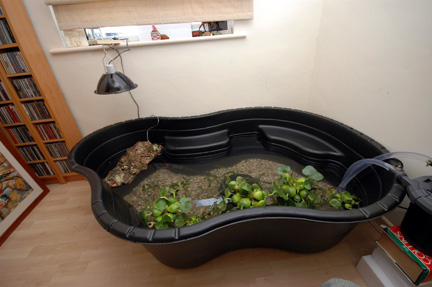
Here is an excellent pond for Map turtles built by Tortoise Trust members. It shows just how attractive these set-ups can really be.
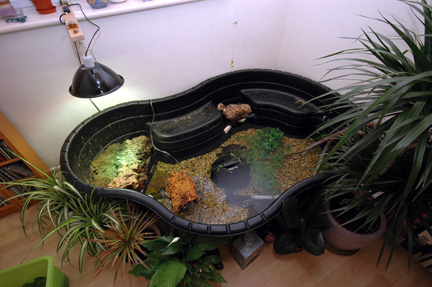
Choosing a pond:
It is
best to choose a pond with a fairly flat, wide base. You
can certainly use ponds that have ‘uplifted’ or raised
areas, but you will have to provide wooden supports or
‘props’ to place between these areas and the floor. We
make such supports, when required, from 3 X 4" lumber
and ½" thick plywood. If you choose a pond with a large,
flat base, and no ‘overhanging’ areas, however, you will
not need these supports. You could also support
‘overhanging’ areas using brick and tiles, if you
prefer. Whatever you use, make sure it has no sharp
edges or protruding screws or nails that could cut into
or damage the pond itself.

Another
great
indoor habitat based on this system
If you choose to raise your pond up higher to keep your turtle out of the reach of a toddler’s fingers or a curious dog, be certain to use very sturdy materials that will be able to withstand the extreme weight of the pond when it is filled with water. We used 1/2 inch plywood with 4 x 4 inch posts to support our 60 gallon pond. Decorative framing materials can also be extended beyond the pond’s upper edge to provide additional protection if needed.
It should be noted that a square or rectangular pond will give more water volume than a curvaceous design, but you may prefer the latter for the sake of appearance.
Cost:
A small pond (45-60 gallons) can be obtained for as little as $30. Larger models range from $45 to $90. This compares very favourably indeed to glass tanks, where models suitable for turtle maintenance typically cost well in excess of $150-$200.
You will also require:
- Submersible aquarium heater, 300 watts (you will need two or more for larger ponds)
- Aquarium heater protection sleeve (to prevent breakage by turtles)
- Pond air pump and air-stone (pond or aquarium ‘aerator’)
- UV-B lighting system (either fluorescent or mercury vapor/’UV-B heat’)
- Flat rocks for basking
- Basking lamp (not required if mercury vapor ‘UV-B Heat’ lamp is used)
- Filter system (see below)
Optional:
- Artificial aquarium plants
- Live aquarium plants (water lettuce, water hyacinth, duckweed)
- Several bags of washed smooth aquarium stones, medium grade
- Bottom drain valve
Choosing a filter:
We have carried out extended trials (12 months) with various different types and makes of filter for use in Surface Mount Pond applications. The models that performed the best of those tested were:
FLUVAL 4 CANISTER FILTER This is quite a large, but reasonably priced, foam-filled canister filter capable of fairly high flow rates. It is the smallest filter we recommend for use in Surface Mounted Ponds. In tests, we ran three separate ponds from 45 to 80 gallons using the Fluval 4, all inhabited by medium-sized Red-Eared Sliders, and they performed very well indeed. You could use Fluval 4’s in larger ponds, but you would need two or more. This filter is fairly low maintenance if installed correctly, only needing the foam media rinsing out in clean water every 10-12 weeks. It is extremely important, that when rinsing, you do not use any antibacterial or sterilizing product – this will kill the beneficial, nitrifying, bacteria that inhabit the filter media and which help to clean the water.
BECKETT POND FILTER This filter is intended for use in small water gardens, and comprises a submersible ‘box’ filter with internal pump, and a fountain outlet with an adjustable side diverter that emerges above water level. The water first filters through two layers of foam, and then enters into the bio-filtration unit containing sphere-shaped clusters of flow-through tubes, called bio-elements, which promote the protected colonization of "friendly" or nitrifying bacteria. Once established, these colonies of bacteria remove harmful ammonia and other waste products from the water. The maximum rate of water flow is 400 gallons per hour, but may easily be reduced as required. In use, it proved extremely reliable and required remarkably little maintenance.
We carried out further trials using a variety of much more expensive filters, including large external canister models, but none offered any advantage over the two filters described above. In fact, the two models recommended here performed better than every other filter we tested, including those at 5 times the price. Although we have used large external canister filters, such as the Fluval 403 with Surface Mounted Ponds, these are not generally as easy to install, as they must be placed at a substantially lower level than the pond base – this is not a requirement of either of the recommended filters (above). Although the models mentioned above are known to function adequately, there is no reason why other substitute filters of similar size and design should not work just as well, so if you are unable to obtain these specific models, all is not lost.
The size filter you require for your pond will be determined by:
- 1. The number of turtles in the pond
- 2. The water volume
- Pond accessories that will reduce flow rate. The optimum flow rate of the small Beckett pond filter is 400 gallons per hour, but this rate can be reduced by any fountain or waterfall that requires the water to be pumped above the surface of the water. Additional reduction will occur when water is pumped through horizontal tubing that runs from the pump/filter unit to the fountain or waterfall. Using appropriate pond accessories and the proper tubing width for your pump/filter will keep these losses to a minimum.
Proper flow rate is of crucial importance to effective filtration. If the water passes through the filter too slowly, it will be insufficient to keep the water clean. If the water passes through too quickly, the bacteria within the bio-elements will not have the time needed to properly break the ammonia and other waste products down into less harmful forms that feed aquatic plants and contribute to a balanced ‘nitrogen cycle’.
We set up one sixty pond for a young adult painted turtle. While installing the small Beckett filter with a flow rate of 400 gallons per hour, we adjusted the flow rate down to allow for less than half that, so the water would circulate through the filter at least twice an hour. If you wish to check on the actual flow rate, this can be easily done by collecting water from the outlet. For example, for a flow rate of twice the volume of water in a sixty-gallon tank (120 gallons), you would expect to be able to collect two gallons of water per minute, or one gallon in thirty seconds.
Boosting filter efficiency:
One of the most important requirements to maximise filter efficiency is that the water should contain adequate levels of dissolved oxygen. This is critical to the proper function of the nitrifying bacteria that inhabit the filter media. If the water is anoxic (low in oxygen) these bacteria may die, biological filtration will cease, and even worse, different types of bacteria that thrive in anoxic conditions will take their place. These are the bacteria that can cause illness in turtles and they will result in a foul smelling, unpleasant pond. It is therefore vital that the water is adequately oxygenated. There are several ways to achieve this, but the easiest is to install a large ‘air stone’ driven by an aquarium air pump, and encouraging the water surface to be agitated continuously. The latter is achieved automatically to some extent using water-garden ‘fountain’ filters, as the fountain outlet does a good job of aerating the water. Most ponds will still benefit from the addition of an air stone, however. In the case of internal canister filters, an air stone is mandatory, and where possible, the use of an extension ‘spray bar’ will also enhance surface agitation, and hence oxygenation. Do not attempt to run these ponds without adequate aeration and oxygenation! It is an essential component of the entire system, and contributes greatly to their effectiveness and low maintenance.
Periodic maintenance is necessary to assure the unobstructed flow of water, and foam pads will need to be removed to rinse off debris that has accumulated. When performing any maintenance on the filter, care should be taken not to disturb the bio-elements, or to rinse away the bacteria that have colonized within them. It takes time for these colonies to establish, and the effectiveness of filtration will suffer if their numbers are diminished during maintenance. Simply rinse the filter foam gently in fresh water sufficiently to remove ‘blocking’ debris. Avoid use of highly treated tap or faucet water for this purpose. In rural areas with good air quality collected rainwater is a possibility, however, in areas with treated tapwater, the use of a high quality water filter is preferable.
Stocking density:
Do not overstock these ponds. A 100 to 120-gallon pond is adequate for one average-sized Red-Eared Slider or Painted Turtle. A 60-gallon pond is fine for two to three juveniles of no more than 2" carapace length, or one smaller young adult.
For two or three adult turtles you will require a pond in the 250-gallon range, and will need at least two submersible internal canister filters or one large-model ‘fountain’ type filter.
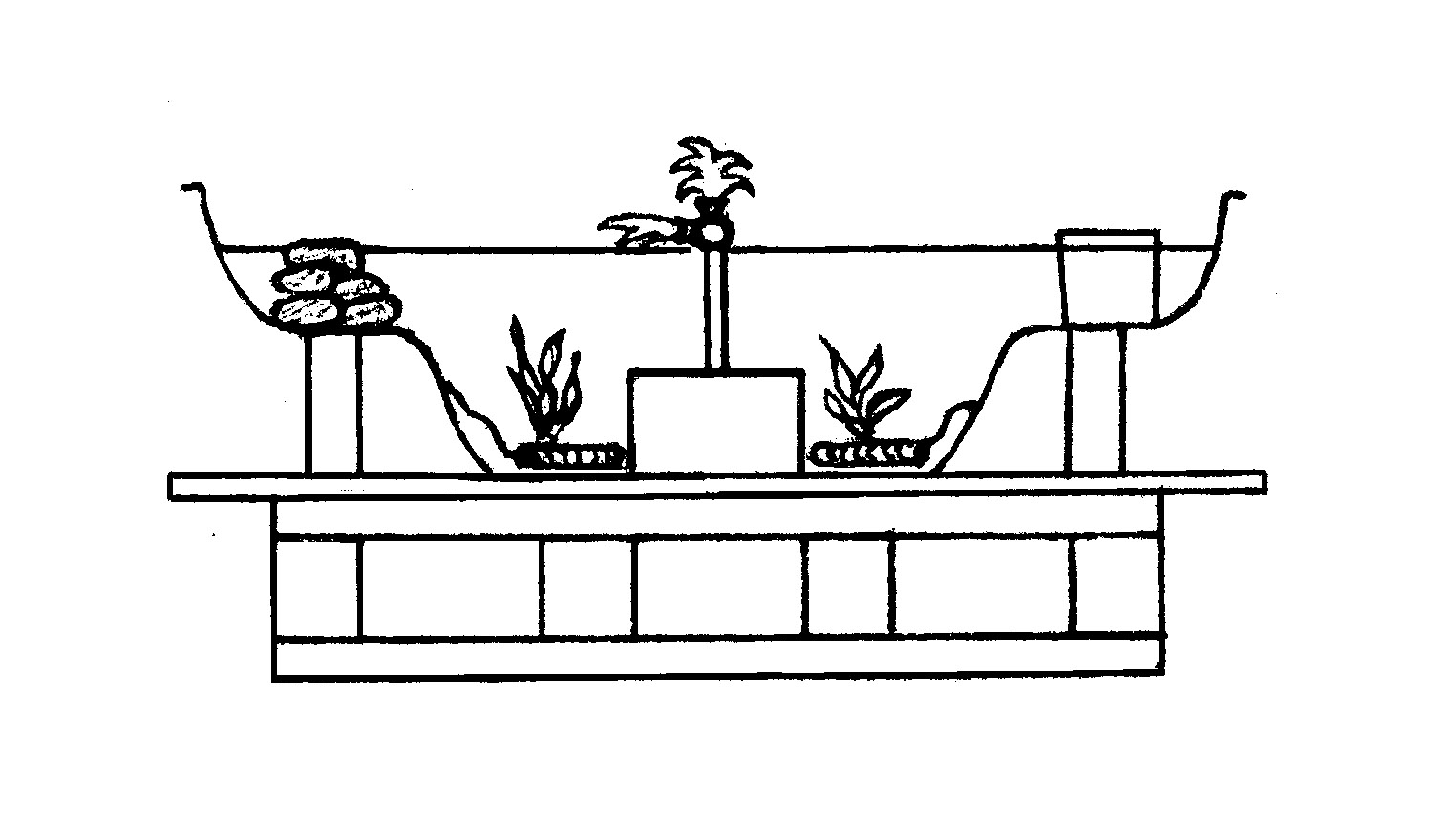 Layout of pond, on raised base, when fitted
with Beckett filter unit
Layout of pond, on raised base, when fitted
with Beckett filter unit
Getting the pond operational:
If a base drain is required, fit this first. Suitable drain valves are available from a variety of sources, including from boating and marine stores, home improvement and hobby centres, and especially from home wine and beer-making suppliers. For small to medium-sized ponds, the ½" to 1" plastic drain valves widely used for "home brew" purposes are in fact ideal. Simply cut a suitable diameter in the side of the pond near to, but not below the intended level of the substrate, and install the valve. For added security from leaks, a smear of aquarium sealant around the valve fixture is recommended. Installation of such a valve greatly speeds up water changes. Please note that the use of a base valve does require that the outlet point from the drain hose should be situated at a lower level than the pond itself. If this is not possible, then we highly recommend the use of the ‘PYTHON’ no-spill water-changing system that is widely available at aquarist suppliers. This requires no holes to be drilled into the pond, and is extremely effective.
- 1. Place pond into position.
- 2. Add an appropriate substrate. We prefer to use an inch-deep smooth stone substrate for most species. A deeper coral sand substrate can be substituted for soft-shell turtles, however (Trionyx/Apalone species). Some people have concerns about gravel ingestion and impaction – we have never experienced this, but if you are worried, you can omit the substrate.
- 3. Fill the pond to the desired depth with fresh, clean water.
- 4. Install the filters and ensure they run correctly.
- 5. Install the submersible heater and ensure water temperature is in the desired range. This may take a few hours.
- 6. Add other decorations as required. Basking rocks should be wedged very firmly into place. They can be dangerous if loose. They can also allow a climbing turtle to escape if placed too close to the edge. You can use aquarium-grade silicone sealant to glue rocks together if necessary. Prepare these in advance and allowed to dry for at least 48 hours before placing them in the water. Some artificial aquatic plants can also be fixed in place at this time. We have found that the silk-type are not as durable, and find some of the natural looking plastics very attractive.
- 7. A land/nesting area can be created by using a large plastic container filled with a 50/50 earth and sand mixture and placing it on one of the shallow shelf areas. Provide a short ramp or group of rocks to allow turtles easy access to the area. Make certain that all rocks and ramp materials are firmly secured and glued into place with aquarium sealant. A short ramp can be made with a piece of cork bark angled into the water from the land area. Take care to not create areas where turtles might get caught under the water and drown. This can and does happen! Avoid "caved" areas and always make it easy for turtles to see and reach the surface. Turtles do like to hide at times, but they will be able to do so more safely in the aquatic plants.
- 8. Some pond filters may come with taller fountain attachments. You may find that when used indoors with smaller ponds that the spray results in water loss and wet floors. Test them to determine their suitability. The diverter in the small Beckett was just the right height to reach above the water level in our 60-gallon pond, which we have pictured in the diagram.
- 9. Allow the pond to stabilise for 3-4 days before adding turtles.
- 10. Ensure that adequate UV-B lighting and basking lamps are available, and are positioned correctly above the basking site. Instead of UV-B fluorescent tubes, you can also use mercury vapor ‘UV-B Heat’ lamps. These provide very good levels of UV-B, and combine this with a substantial heat output. They are ideal for use in installations of this type.
- 11. You can, if you wish, decorate the external aspects of the pond using wooden ‘log roll’ or artificial rocks. In this way, the pond can become a highly attractive and unusual feature of your home. Surrounded by artificial rocks and tropical plants, these ponds, with their trickling water and bright lighting are a beautiful and relaxing addition to any lounge or office! Things you can do to improve the pond even more
Avoid over-feeding, and especially, do not feed oily fish or fatty meats. These cause serious hygiene problems and will greatly increase the need for complete water changes and for filter maintenance. Instead, base your diet on a combination of Reptomin, Trout Chow, hydrated dried low-fat cat ‘crunchies’ and fresh salads. Add a phosphorus-free calcium supplement to each meal. Many turtles, including Red-Eared Sliders are highly herbivorous once past the immediate hatchling stage. The details vary according to species, of course, but you should not concentrate on animal-proteins alone – many turtles are far more herbivorous than most people imagine. Including a healthy variety of green-leaf salads in your turtle’s diet can make a tremendous difference to their health and longevity. On this subject, we highly recommend including some floating, fresh aquatic plants in the pond. Most turtles love to nibble at these, and they also look extremely attractive.
Indoor ponds not only provide excellent water quality, and low maintenance at a very reasonable cost, and with some decorative touches can be a beautiful addition to your home, and an ideal indoor accommodation for your turtles.
We hope that these guidelines have removed any hesitancy you may have had to create your own indoor pond and that you and your turtles will soon be enjoying the many benefits they provide.
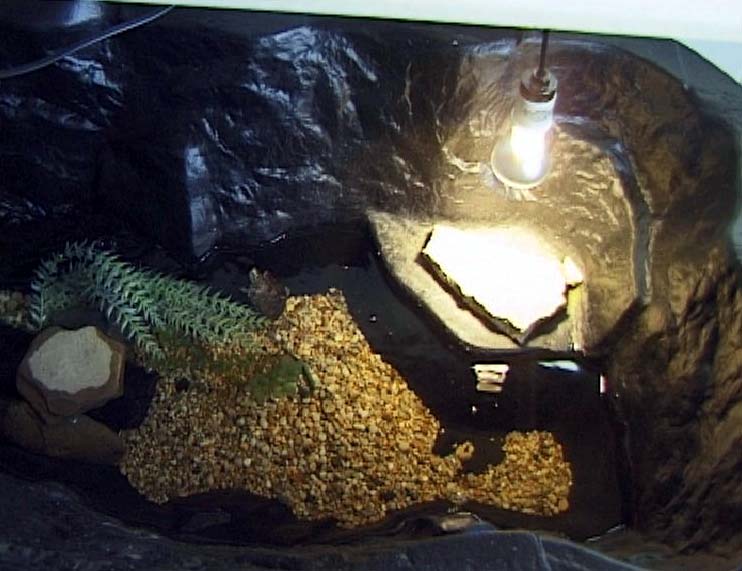 Pond basking stone area with overhead UV-B Heat
lamp.
Pond basking stone area with overhead UV-B Heat
lamp.
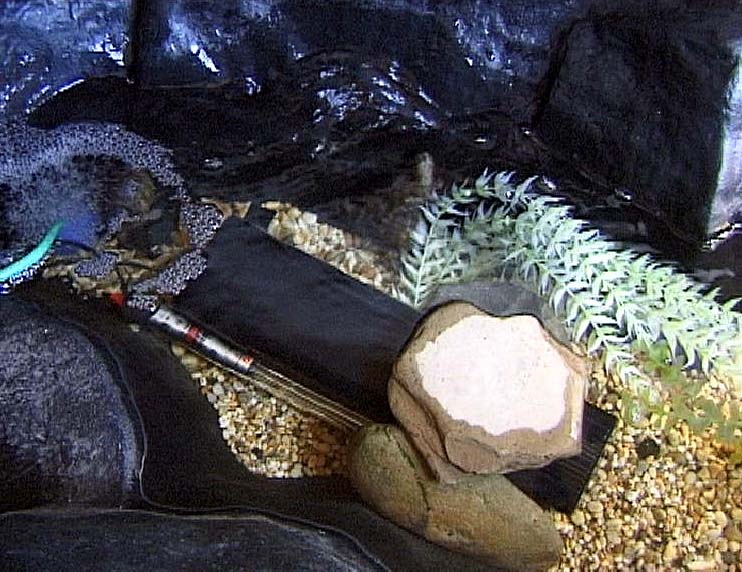 Pond with Fluval model 4
canister filter installed
Pond with Fluval model 4
canister filter installed
Further reading on this site:
Lighting for tortoises and turtles
Red-Eared Slider facts and disease prevention
Mauremys turtles of the Mediterranean - Care and Breeding
Creating 'Natural' environments for aquatic turtles
Tortoise Trust 2001-2010